Retinal laminar architecture in human retinitis pigmentosa caused by Rhodopsin gene mutations
- PMID: 18385078
- PMCID: PMC3179264
- DOI: 10.1167/iovs.07-1110
Retinal laminar architecture in human retinitis pigmentosa caused by Rhodopsin gene mutations
Abstract
Purpose: To determine the underlying retinal micropathology in subclasses of autosomal dominant retinitis pigmentosa (ADRP) caused by rhodopsin (RHO) mutations.
Methods: Patients with RHO-ADRP (n = 17, ages 6-73 years), representing class A (R135W and P347L) and class B (P23H, T58R, and G106R) functional phenotypes, were studied with optical coherence tomography (OCT), and colocalized visual thresholds were determined by dark- and light-adapted chromatic perimetry. Autofluorescence imaging was performed with near-infrared light. Retinal histology in hT17M-rhodopsin mice was compared with the human results.
Results: Class A patients had only cone-mediated vision. The outer nuclear layer (ONL) thinned with eccentricity and was not detectable within 3 to 4 mm of the fovea. Scotomatous extracentral retina showed loss of ONL, thickening of the inner retina, and demelanization of RPE. Class B patients had superior-inferior asymmetry in function and structure. The superior retina could have normal rod and cone vision, normal lamination (including ONL) and autofluorescence of the RPE melanin; laminopathy was found in the scotomas. With Fourier-domain-OCT, there was apparent inner nuclear layer (INL) thickening in regions with ONL thinning. Retinal regions without ONL had a thick hyporeflective layer that was continuous with the INL from neighboring regions with normal lamination. Transgenic mice had many of the laminar abnormalities found in patients.
Conclusions: Retinal laminar abnormalities were present in both classes of RHO-ADRP and were related to the severity of colocalized vision loss. The results in human class B and the transgenic mice support the following disease sequence: ONL diminution with INL thickening; amalgamation of residual ONL with the thickened INL; and progressive retinal remodeling with eventual thinning.
Figures
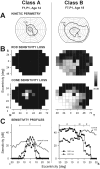
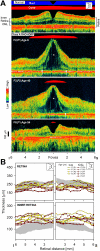

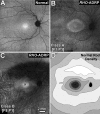
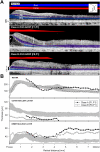
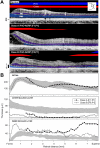
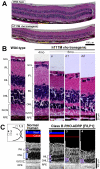
References
-
- Gal A, Apfelstedt-Sylla E, Janecke AR, Zrenner E. Rhodopsin mutations in inherited retinal dystrophies and dysfunctions. Prog Retinal Eye Res. 1997;16(1):51–79.
-
- Kennan A, Aherne A, Humphries P. Light in retinitis pigmentosa. Trends Genet. 2005;21(2):103–110. - PubMed
-
- Hartong DT, Berson EL, Dryja TP. Retinitis pigmentosa. Lancet. 2006;368(9549):1795–1809. - PubMed
-
- Palczewski K, Hofmann KP, Baehr W. Rhodopsin–advances and perspectives. Vision Res. 2006;46(27):4425–4426. - PubMed
Publication types
MeSH terms
Substances
LinkOut - more resources
Full Text Sources
Other Literature Sources
Molecular Biology Databases
Research Materials

